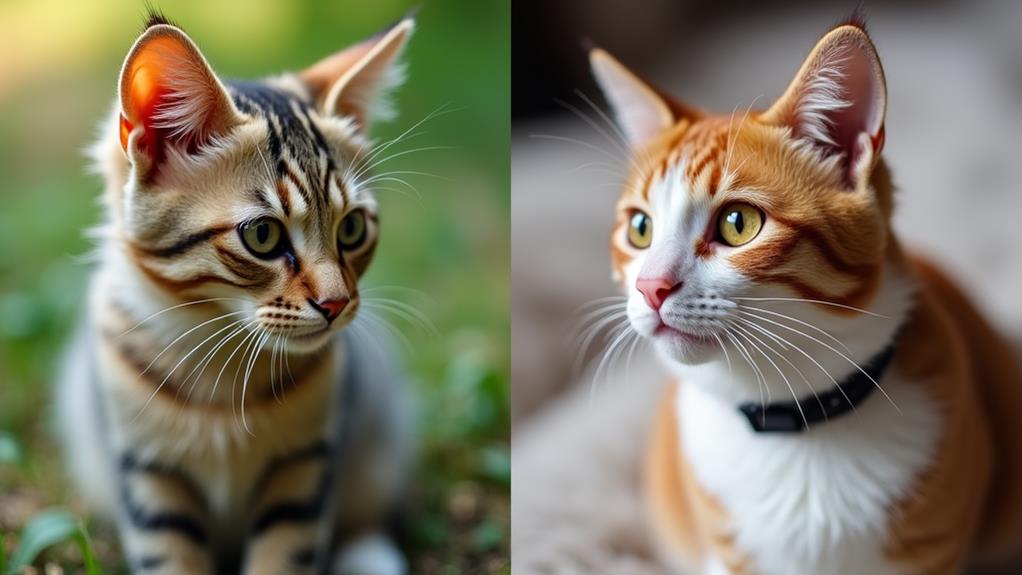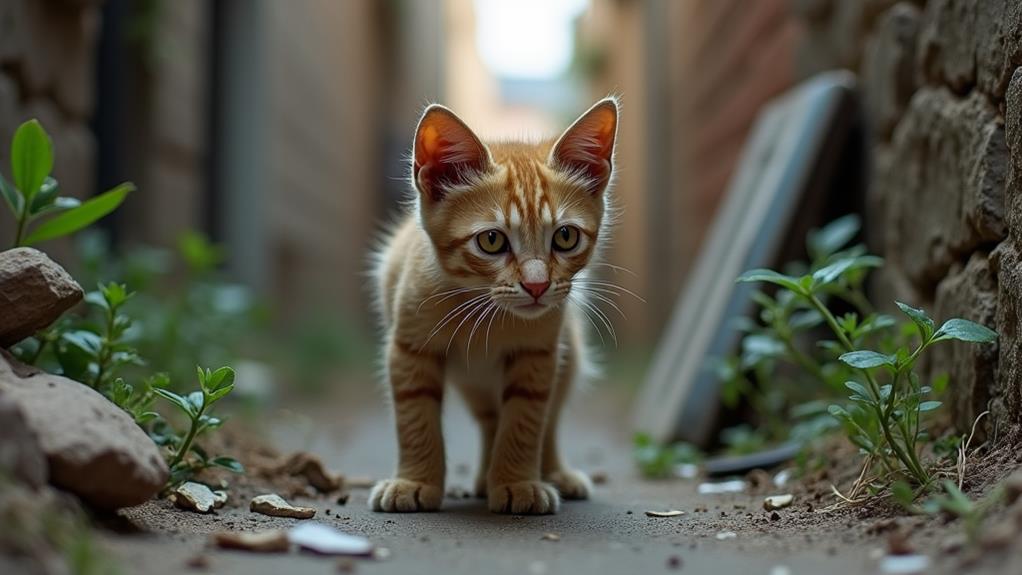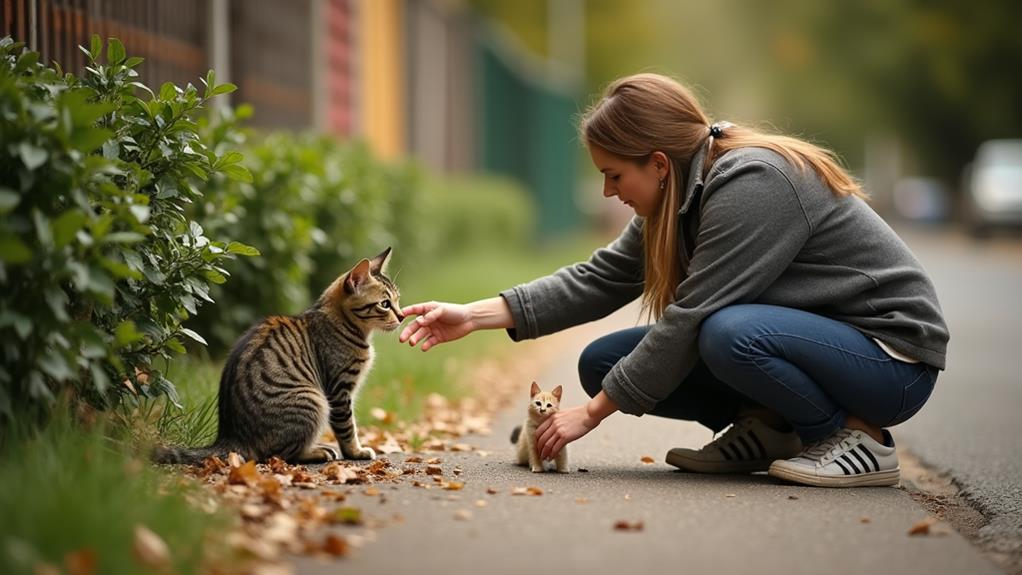How to Tell if a Cat Is Feral or Lost: Identifying a Cat's Background

To identify if a cat is feral or lost, observe its behavior and appearance. A stray or lost cat typically seeks human interaction, meows for attention, and may rub against your legs. They often look relatively clean and show relaxed body language. In contrast, feral cats are wary, avoid humans, and rarely vocalize. Their fur might be matted, and they display defensive postures and behaviors. Approach carefully, as sudden movements can cause feral cats to flee. Community participation in Trap-Neuter-Return programs is key in managing feral populations. Exploring further reveals effective strategies for interacting and supporting these cats.
Understanding Cat Socialization
Understanding a cat's socialization is essential to determining if it's feral or simply lost. Socialization involves how accustomed a cat is to human interaction and environments. Stray and feral cats differ greatly in their socialization levels. Stray cats, once pets, likely had positive human interaction and can often be re-socialized, adapting back into domestic life. You'll notice a stray might be approachable, vocal, and exhibit friendly body language, indicating some level of comfort with humans.
Feral cats, on the other hand, have had little to no positive human interaction during important socialization periods. This lack of exposure makes them more fearful or aggressive toward humans, and they tend to avoid contact. Their body language often shows signs of stress or defense, like hiding or hissing, which underscores their wild nature. Understanding these differences is crucial for animal welfare organizations, which often engage in community cat management programs.
Programs like Trap-Neuter-Return (TNR) rely on recognizing these socialization differences to provide appropriate care. By evaluating a cat's behavior and body language, you can play an essential role in ensuring they receive the care and intervention they need.
Behavior of Stray Cats
Many stray cats, often once pets, exhibit behaviors that reflect their past human interactions. Unlike feral cats, which usually flee or hide, strays might display signs of anxiety and fear around people. This behavior suggests they've been socialized to human environments at some point. When you encounter a stray cat, you might notice it cautiously approaching you or even rubbing against your legs, indicating a level of comfort with human contact. This contrasts sharply with feral cats, who typically avoid eye contact and maintain a safe distance.
A stray cat may vocalize, meowing to grab your attention, something feral cats tend to avoid, as they're generally silent around humans. This vocal communication is a clear indicator the cat might be a lost pet rather than a feral one. Stray cats are usually solitary, but they may tolerate some interaction with humans, showing a willingness to reconnect with their domestic past. With patience and care, you can often rehabilitate a stray cat, helping it revert back to a domestic life. This is quite different from feral cats, which have limited human interaction and prefer to remain distant.
Traits of Feral Cats

When trying to differentiate between feral and stray cats, look for the distinct traits that feral cats exhibit. Feral cats typically display avoidance behavior, often fleeing or hiding when you approach. This behavior stems from their lack of socialization with humans, making them wary of contact. Unlike socialized cats, feral cats won't seek affection or interaction. Instead, they'll keep their distance, avoiding any direct engagement.
Their appearance can also give you clues. Feral cats often have an unkempt look, with matted fur and a generally scruffy demeanor. This contrasts with the cleaner, more groomed appearance of domesticated or stray cats that might have recently been cared for. Also, the absence of collars or identification tags is common among feral cats, as they've likely never been owned.
In terms of vocalizations, feral cats use loud, guttural sounds defensively when they feel threatened. This differs from the meows and purrs of a socialized cat. Additionally, feral cats exhibit strong hunting instincts. You might notice behaviors like stalking and pouncing, which are essential adaptations for their survival in the wild. Recognizing these traits can help you identify a feral cat accurately.
Differentiating Stray and Feral
In the quest to differentiate between stray and feral cats, you'll notice distinct behavioral cues that set them apart. Stray cats, often former pets, tend to be more socialized and may actively seek contact with humans. They might approach you, meow, or even rub against your legs, signaling their comfort with human interaction. In contrast, feral cats usually avoid humans, displaying fearful body language such as crouching or hiding.
Stray cats often appear clean and well-groomed, as they've been accustomed to indoor environments. Their previous contact with humans makes them more amenable to rehabilitation and potential reintroduction into domestic life. On the other hand, feral cats typically have an unkempt appearance, a reflection of their survival in outdoor conditions without human care. Their lack of socialization means they're less likely to adapt to indoor living.
Kittens born to stray cats have higher chances of becoming socialized with appropriate human interaction early on. However, those born to feral mothers require significant effort and early intervention to be rehabilitated. Understanding these differences is essential when determining how to approach and assist these cats.
Observing Cat Interactions

Spotting the difference between feral and lost cats often hinges on observing their interactions with humans and other animals. When a cat is feral, it typically avoids human contact, quickly fleeing or hiding when approached. In contrast, a stray cat, which may be lost, often displays anxiety but still seeks human interaction. Observing a cat's behavior can help you determine its background. For instance, a stray might meow or show friendly body language, like approaching or rubbing against people. On the other hand, feral cats tend to remain silent and exhibit fearful postures, indicating their preference for solitude.
Additionally, feral cats usually live solitary lives or form colonies for survival, while strays often have a history of human interaction and show signs of socialization. If you notice a cat without a collar or identification tags, it's more likely to be feral, as lost pets may still wear identification. By observing from a distance, you can gauge the cat's comfort level. Strays may cautiously approach humans, indicating some familiarity, while feral cats will typically retreat to a safe spot, underscoring their wary nature and lack of human socialization.
Physical Signs to Note
Noticing physical signs can be key in distinguishing between feral and lost cats. Start by observing the cat's appearance. Feral cats often have a scruffy, unkempt look with matted fur, revealing a life without human care. In contrast, stray cats, or those that are lost, might look dirty from being outside but usually have a more groomed coat, indicating they've had some past human care. Check for collars or identification; feral cats typically don't have these, while lost cats may wear collars with tags or could be microchipped.
Pay attention to the cat's body language. Feral cats display defensive postures, often crouching with flattened ears, and might retreat or hide if you approach. They're generally wary of humans and might not seek interaction. On the other hand, stray cats usually exhibit more relaxed postures and may approach humans, indicating a previously domesticated lifestyle.
Vocalizations are another clue. Feral cats tend to be quiet, using limited, guttural sounds to signal defensiveness. In contrast, lost cats are more likely to meow or vocalize in a friendly manner, seeking attention and help from humans. These signs together can help you determine a cat's background.
Safe Approach Techniques

Understanding a cat's background through physical signs is just the beginning; how you approach it is likewise significant for ensuring safety. Start by maintaining a respectful distance. Feral cats are often skittish, and sudden movements might startle them, causing them to flee or act defensively. Observing their body language is vital. A lost cat might exhibit a more relaxed posture, while feral cats often crouch or hide, signaling fear.
Use calm vocalizations and gentle hand gestures to indicate you're not a threat. Friendly strays might respond positively to your voice, whereas feral cats typically remain aloof or choose to retreat. Consistently providing food can help build trust; a stray might start approaching you over time, although a feral cat will probably keep its distance even during feeding.
If you suspect the cat is lost, look for a collar or microchip. This step is key, as it can provide clues about ownership and assist in reuniting the cat with its family. By employing these safe approach techniques, you can better manage interactions and determine if a cat is feral or simply a lost cat.
Utilizing TNR Programs
When managing feral cat populations, utilizing Trap-Neuter-Return (TNR) programs is essential. TNR programs humanely trap feral cats, spay or neuter them, and return them to their original locations. This method effectively controls cat populations and improves their health and well-being. By preventing unwanted litters, TNR markedly reduces the number of kittens born in feral colonies, helping stabilize the population over time.
In addition to population control, TNR programs also decrease nuisance behaviors like yowling and fighting. As cats are spayed or neutered, these behaviors diminish, making them less disruptive in their environment. This stability allows you to monitor feral cat colonies more effectively, providing consistent food and medical care to guarantee their well-being.
A key part of TNR is ear-tipping, where a small portion of the cat's ear is removed. This visible marker helps you easily identify cats that have been spayed or neutered, preventing unnecessary re-trapping and reducing stress on the animals. While TNR primarily addresses feral cats, it can also help identify lost cats, as those without ear-tipping may be domesticated or recently lost, requiring different care strategies.
Community Cat Support Options

Although managing feral cat populations can seem challenging, community cat support options provide effective strategies to tackle this issue. Participating in Trap-Neuter-Return (TNR) programs is a significant approach. TNR helps control feral populations by preventing unwanted litters, which in turn improves the general health and stability of these cats.
Setting up feeding stations is another important aspect. By providing a reliable food source, you not only help establish trust with the cats but also minimize their need to scavenge, which can sometimes lead to conflicts with humans. Feeding stations guarantee that community cats have consistent access to nutrition, aiding in their health maintenance.
Local animal welfare organizations are fantastic resources. They offer guidance on managing feral colonies and can assist with trapping and medical care. By volunteering, you can help monitor these populations, making sure cats remain healthy and that overcrowding is avoided.
Additionally, engaging in community outreach to educate about responsible pet ownership is essential. Reducing the number of lost and abandoned cats benefits both strays and ferals. By promoting responsible pet practices, you contribute to a healthier and more balanced coexistence with community cats.




